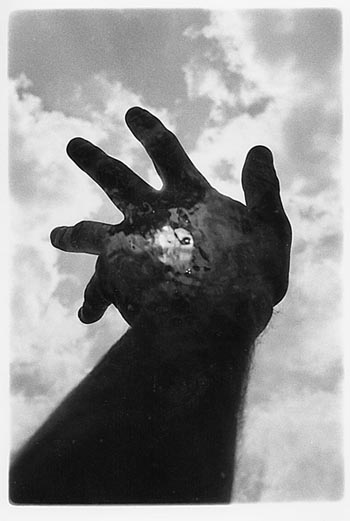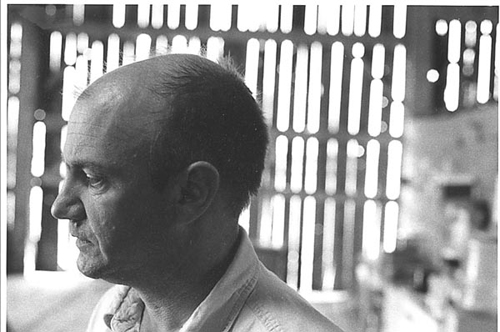By Ken Paul Rosenthal
from http://www.incite-online.net/rosenthal.html

I am flying on Air Canada to Phil Hoffman’s Independent Imaging/Filmmaking Retreat on a farm northwest of Toronto, where I will shoot and process motion pictures, learn tinting and toning, and view contemporary experimental films. It’s been 11 years since I was introduced to the tactile universe of hand processing movie film at the San Francisco Art Institute. Watching the beautiful mess of images emerge from a stainless steel womb for the first time entirely changed the way I make films.
Hand processing is a practice where serendipity is the rule rather than the exception; an antidote to conventional methods of filmmaking that emphasize image control. Whereas new technologies moved me away from the medium, I could use my own hands to embrace the film material more directly and intimately. Over the years I have hand-processed hundreds of rolls of film and shared my experiences in dozens of workshops. Now I’d have an opportunity to learn recipes and techniques from other passionate practitioners and work in 16mm for the first time.
The stewardess offers me headphones for the onboard movie, but I decline and turn my attention instead to the film unraveling outside the cabin window. The sifting contours of the clouds remind me how much hand-processing movie film is like playing in a celluloid sandbox. It can also be quite terrifying. You discover your heart isn’t as malleable as the medium, and you start scraping away at it until only the most precious cell is left. That frame, that naked grain, is your silver soul.
Mount Forest, Canada
I am standing alone in an open barn door. In front of me a tree traces the grass with tender brushstrokes. I turn and enter the barn, where pillars of light ring the space like a motionless zoetrope. It is the morning after the retreat has ended, and I’m still nursing my last shot of solitude.
Although the 11 other participants have departed, the after-effects of five days of nonstop filmmaking are evident everywhere. Glistening strips of hand-processed film drip-dry and flutter from a 15-foot clothesline inside the barn. My own footage wraps around the line in impossible tangles. Short, crazy-colored pieces of film swim in bowls of toning solution. Half-eaten bits are stuck to the fridge like a proud child’s schoolwork. Sheets of opaque plastic cordon off the darkrooms. Just yesterday those same plastic curtains barely dampened the giddiness of fellow processors, who emerged from the darkrooms like proud parents, shouting, “Oh my God, look at this!” as people scurried over to see their newborn images, launching into a chorus of “Oohs,” “Ahhs” and “Wowwws.”
The film retreat was a carnival of creativity, and the barn was the funhouse. At least it was for most of the participants. Looking back, I can’t help but wonder; what was I doing in the farmhouse cellar futzing with my Bolex’s rex-o-fader for two hours while the resident sparrows were pooping on my head? How did I expose an entire day’s shoot to a 100-watt light bulb before it hit the first developer? And why the hell did I go ahead and process it anyway?! Instead of producing images, I made a series of increasingly catastrophic mistakes. Why was it so difficult to practice what I’d long been preaching to my hand-processing students: dissolve prescribed ideas and embrace the process from which the most elegant visions arise?
When I arrived six days earlier, I was prepared to make a dance film. That ambition quickly dissolved when I took on a Bolex Rex-4 as my shooting partner. Having only shot with highly mobile Super-8 cameras for the past 15 years, I found the 16mm Bolex a beast to handle. Using a Sekonic meter to read the light, stopping down the aperture and then recompose before shooting didn’t feel spontaneous. Instead of embracing the Bolex’s noble weight and its economy of functions, I kept wrestling with it. The camera didn’t fight back, it just sort of went away, piece by piece.
Over the next two days I lost the backwind key, a 24-inch cable release, and the filter slide (thus fogging an entire day’s shoot). I also stripped the threading in the crankshaft. With each additional piece of equipment lost or broken, I was forced to peel back another layer of intention. I let go my idea of making a dance film, and I let go my desire to leave the farm with a finished film. After all, I was always reminding my students that film is less about making a film than it is about experiencing the making. And that the texture of the gesture becomes the film. Now I needed to take my own advice.
However, abandoning the images and ideas I had developed in my mind filled me with despair. Without a script or a preconceived vision to guide me, I felt crippled and blind. I did not know which side of the camera to place my attention on, and collapsed to the ground. It was at that moment that an image came to me—my hand reaching through the lens and fondling the sun. I thought about my little focus-free 35mm still camera (which had slipped out of my pocket into a bucket of water that morning) and how liberating it felt to point it and just shoot whatever I found beautiful.
I stood up and immediately began filming in the same way I had made still pictures, without any camera movement, simply framing my subjects for their texture and the way they embodied the light. I shot burlap riding the wind. I shot barbed wire choking wild straw. I shot a newborn calf’s placenta until an irate bull chased me headlong through the electric sting of a charged fence. As the Bolex and I moved arm in crank through pastures and forests, I realized I was making a dance film after all. Only the dance wasn’t taking place in front of the lens, but in the space between the camera body and my own. And I realized that my struggles had not been about making mistakes or knowing what to shoot, but about how to compose my self. I had taken a shot of my solitude, and it was a good fix.
Everyone’s activity reached a fever pitch on the fifth and final day in preparation for our evening screening. Filmmakers darted from pasture to darkroom to flatbed in frenetic circles, with pit stops at the tinting table, optical printer or homemade animation stand. The resident Steenbeck had a wonderful malfunction, which caused the plates to clang like a locomotive pulling into a station, or dinner bell calling everyone to our celluloid feast.
An hour before showtime I chose my selects, drew up a paper edit and assembled a rough-cut. As I hastily sifted through reel after reel of misfortune, a few silver jewels began to emerge. After my piece screened, a warm shivering welled up in my chest as I shared the details of my innumerable mishaps. Although everyone applauded my work’s photography, the images of my solemn, distended shadow hugging an endless road, of rotting barn shingles and a lonely leaf framed against a setting ball of sun were documents of my solitude.
Now it’s the morning after the retreat has ended, and I am standing alone in the barn wondering what to do with my film, with myself. Should I return to the fields and re-shoot all my mistakes? Should I bury my film in front of the barn, where exhausted chemistry had spilled? Or should I just chuck the whole mess into a vat of blue toner? The answer gently materializes when I stop asking questions: continue filming what I find beautiful—the film material and the process of making film. I shoot film images rising out of a chemical bath, film stock spilling into a discarded porcelain sink, film strewn across a long row of bushes and negative film reversing to positive under a light bulb.
With only two hours before my departure, I find the courage to pull off my fantasy shot with the help of Christine Harrison, one of the retreat assistants. We leave the farm and head toward an enormous field of daisies, where I plan to have Christine film me prancing naked in slow motion with an armload of film. We arrive and knock on the door of a private residence neighboring the field to ask permission, but no one answers, so we get right to it. I strip down, then leap and roll about, trampling daisies with blissful abandon. Each time a car approaches on the road, I duck down into my robe of blossoms. As a comic counterpoint, I decide to stand center-frame with a ball of film covering my genitals while I peer about timidly. We are setting up the shot when Christine alerts me to an approaching truck. I figure an 18-wheeler will consider my daisy cheeks worth no more than a toot of his horn. Instead he slams on the brakes and screams bloody murder. This draws out the woman from the nearby residence, whom we thought wasn’t at home. She begins to scream about there being children in the house and threatens to call the police. (Could it be they don’t appreciate dance?)
We gather up clothing and equipment in such haste that my eyeglasses are left behind. So we dash back to retrieve them, but find nothing among the yards of smashed blossoms. Christine seems particularly unnerved. I’m not sure if it’s because the authorities might confiscate our equipment, or because the reputation of the film camp would be irreparably damaged. Regardless, she promises to return that night to search some more, and I drive off to Toronto with the entire world looking like a four-laned fishbowl.

So went my experience on the film farm. I danced with my dark side, my light side and all the other gradations of my silver soul. I lost my eyesight in one sense and gained insight in another, as corny as that sounds. I know deeply and intimately that film is (for me) fundamentally not about recording a picture. It is a process even broader than the developing of images. It is about dancing with stillness and manipulating a novel posture for my heart. Phil Hoffman, the compassionate angel who manages the farm, says that film is about the moment of transformation, and that making love for your self is a reason to make film. Words to shoot by indeed.
I have yet to process the film I shot on my last day at the farm, but that’s OK. I only exposed it as a means to a beginning.
ABOUT THE AUTHOR
Ken Paul Rosenthal is an independent filmmaker, teacher and activist. His films weave personal and political narratives into natural and urban landscapes. Rosenthal is the recipient of a SAMSHA Voice Award for his media work in mental health advocacy, and a Kodak Award for Cinematography He holds an MA in Creative & Interdisciplinary Arts, and an MFA in Cinema Production.